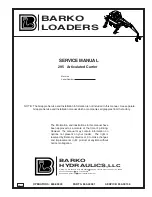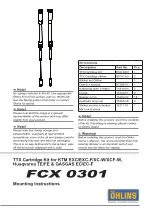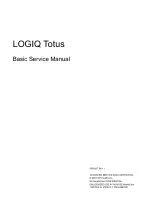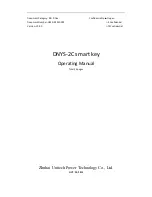
P
AGE
4-5
T
RILOGY
S
ERVICE
& T
ECHNICAL
I
NFORMATION
1002735, V
ER
. 05
12VDC Supply -
The dual switcher (U2) generates the 12VDC (2.5A max) supply using the 29VDC nominal
supply from the power management. This supply is used by the MOSFET driver IC’s, CCFL inverter, the front
panel LEDs and to generate the 7VDC power supply for the sensor board.
5VDC Supply -
The dual switcher (U2) generates the 5VDC (2.5A max) supply using the 29VDC nominal
supply from the power management. This supply is used to generate the 3.3VDC supplies, power the motor
hall sensors, power the system protection circuits and power some components on the interface board.
14VDC Supply -
The step down switching regulator (U18) generates the 14VDC supply. This is a dedicated
power supply to power the sensor board.
3.3VDC Supply
- There are several 3.3VDC supplies generated on the system board.
•
Buck regulator (U5) generates the 3.3VDC supply for the DSP. The 3.3VDC li-ion supply gener-
ated on the power management board acts as a back up to this supply
•
Linear voltage regulator (U6) generates the 3.3VDC supply used by the analog signal conditioning
circuits
•
Step-down DC/DC converter (U4) generated the 3.3VDC supply for the CPU
•
Linear voltage regulator (U3) generates the 3.3VDC supply for the CPLD
Power Fail Supply -
The 5VDC supply is also used to charge the 2.5F ultra capacitor (C113). In the event of a
power failure, the DC/DC converter (U24) uses the charge stored in the ultra capacitor to generate 4.8VDC
nominal supply for power failure alarm generation.
Digital Signal Processor (DSP) -
The Trilogy system board uses the DSP (U7) to control the motor and acts
as a watchdog for the main CPU. It uses internal timers, interrupts, PWM, ADC and peripherals to run the
motor control algorithm. It has six 12-bit ADC inputs available used to monitor motor voltage, DC to DC output
voltage, motor current, system current, 1.2VDC reference voltage and motor temperature. It uses the SPI bus
to communicate with the sensor board and the 16-bit I/O expander (U17).
Complex Programmable Logic Devices (CPLD) -
The CPLD is used for power fail operations, low power
mode, power up/wakeup and alarm functions of the Trilogy ventilator. It has a dedicated JTAG programming
connector (J9) and operated of a 3.3VDC supply.
DC-DC Converter -
The DC to DC converter controls the voltage and current applied to the motor to produce
the desired speed. The converter consists of two N-channel FETs (Q3 & Q4) with an LC filter output stage. The
LC filter reduces both the ripple current and ripple voltage. The FETs are driven by the half bridge power
MOSFET driver (U10) controlled by the DSP. It also acts as a buffer between the motor control and the rest of
the system through a blocking diode (CR10).
3 Phase Motor Inverter -
The current through the six phases of the motor are controlled using the inverter.
The inverter produces multi-phase current of variable frequency to provide the appropriate torque to control the
motor speed. The inverter stages consist of three half bridge power MOSTFET drivers (U13, U15 & U16)
controlling six N-channel MOSFETs (Q6 to Q11). The control signals for the driver are generated by the DSP.
Motor (external) -
The motor used is a Brushless DC motor with low inductance, a WYE wound stator and 3
hall sensors located 120° apart (J5). A built in temperature sensor mounted on the motor board is used by the
DSP to monitor the motor temperature.
Off Board Storage Capacitor -
An off board bulk capacitor (J6) stores the regenerative energy of the motor
during deceleration. It provides the ripple current necessary to accelerate and decelerate the motor and filter
the motor free wheeling voltage from damaging the MOSFETs.
Over Voltage Protection -
The comparator (U31) determines if an over voltage condition occurs on the high
side of the DC-DC converter. If the measured voltage exceeds 35V, a precision current (U33 & Q28) sink is
enabled to shunt current through the bleeder resistors (R174 & R175).
Summary of Contents for Trilogy 02
Page 1: ...Trilogy 100 Trilogy 200 Trilogy 02 Trilogy 202 Service Technical Information ...
Page 177: ...PAGE 8 16 TRILOGY SERVICE TECHNICAL INFORMATION 1002735 VER 05 3 4 5 ...
Page 181: ...PAGE 8 20 TRILOGY SERVICE TECHNICAL INFORMATION 1002735 VER 05 6 ...
Page 184: ...PAGE 8 23 TRILOGY SERVICE TECHNICAL INFORMATION 1002735 VER 05 ...
Page 343: ...PAGE 10 40 TRILOGY SERVICE TECHNICAL INFORMATION 1002735 VER 05 ...
Page 346: ...PAGE 10 43 TRILOGY SERVICE TECHNICAL INFORMATION 1002735 VER 05 ...
Page 351: ...PAGE 10 48 TRILOGY SERVICE TECHNICAL INFORMATION 1002735 VER 05 ...
Page 352: ...PAGE 10 49 TRILOGY SERVICE TECHNICAL INFORMATION 1002735 VER 05 ...
Page 353: ...PAGE 10 50 TRILOGY SERVICE TECHNICAL INFORMATION 1002735 VER 05 ...
Page 354: ...PAGE 10 51 TRILOGY SERVICE TECHNICAL INFORMATION 1002735 VER 05 ...
Page 418: ...PAGE 12 5 TRILOGY SERVICE TECHNICAL INFORMATION 1002735 VER 05 ...
Page 419: ...PAGE 12 6 TRILOGY SERVICE TECHNICAL INFORMATION 1002735 VER 05 ...
Page 420: ...PAGE 12 7 TRILOGY SERVICE TECHNICAL INFORMATION 1002735 VER 05 ...
Page 421: ...PAGE 12 8 TRILOGY SERVICE TECHNICAL INFORMATION 1002735 VER 05 ...
Page 422: ...PAGE 12 9 TRILOGY SERVICE TECHNICAL INFORMATION 1002735 VER 05 ...
Page 423: ...PAGE 12 10 TRILOGY SERVICE TECHNICAL INFORMATION 1002735 VER 05 ...
















































